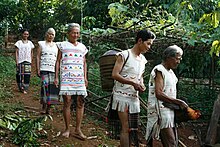|
Mạ people
The Mạ or Maa (Vietnamese: Người Mạ) are a Mon–Khmer indigenous people of Vietnam; as of 2019, they had a population of 50,322. They are concentrated mostly in the Lâm Đồng and Đồng Nai province of the country, particularly in the area of the upper Đồng Nai River.[2] They are very close to the Koho people. The Ma achieved some form of political unity and a stratified society before the 19th century due to the influence of the Funan.[2] This, however, broke down due to varying factors such as the French colonization, inter-group warfare, and slave trading.[2] The Mon-Khmer-speaking group called Cho Ro is identified by some ethnologists as a subgroup of the Ma people.[3] CultureLanguageThe Mạ or Maa language comes under the Mon-Khmer Group: this and the Koho language are sometimes considered to be different dialects only. Jean Boulbet[4] and Lê et al. describe the following Mạ subgroups.[5] There are over 16,000 Mạ people living in Lộc Thắng, Lộc Bắc, Lộc Tân, Lộc Lâm, Lộc Ngãi, and Lộc Châu communes in Bảo Lộc District; Đạ Teh, Đạ M’rê, Đạ Huoai, Đồng Nai, and Ma Đa Gui communes in Đạ Huoai District; Đạ Đờn and Phú Sơn communes in Đức Trọng District; Đinh Trang Thượng commune in northern Di Linh District (Lê et al. 2014:310). These districts all belong to Lâm Đồng Province.
Le (2003)[6] covers the Maa varieties of Dagui, Chop, and Tadung. FolkloreThe Mạ have a rich oral traditions, and their culture is a tapestry of folklore. Myths, parables, and legends are an integral part of this ethnic group.[7] A detailed description the beliefs, customs, ethno-geography and botany of the Mạ people is given by fr:Jean Boulbet, having lived in what is now the Cát Tiên and Bảo Lâm districts in the 1950-60s: before the extensive influx of lowland people to the region.[4] Traditional attireThe Mạ are also known for their traditional colorful attire. Mạ women wear skirts that reach well below their knees. The men customarily wear loincloth.[4] References
|
||||||||||||||||||
